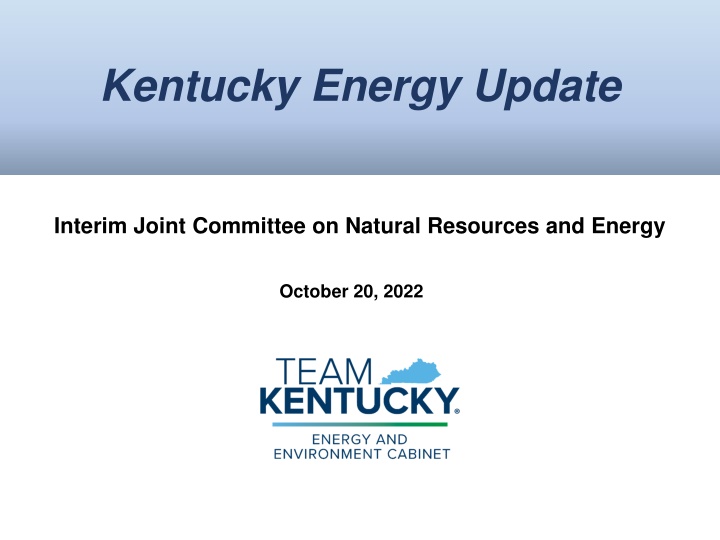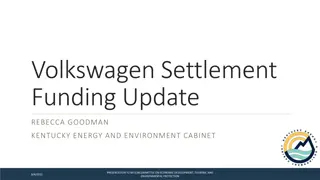Kentucky Energy Update - Coal Industry Statistics
The data showcases Kentucky's coal industry statistics including coal employment, severance taxes, production, permits, and licenses from 2020 to 2022. Details on coal employees, severance tax revenues, production volumes, permits issued, and mine licenses are presented visually.
Download Presentation

Please find below an Image/Link to download the presentation.
The content on the website is provided AS IS for your information and personal use only. It may not be sold, licensed, or shared on other websites without obtaining consent from the author.If you encounter any issues during the download, it is possible that the publisher has removed the file from their server.
You are allowed to download the files provided on this website for personal or commercial use, subject to the condition that they are used lawfully. All files are the property of their respective owners.
The content on the website is provided AS IS for your information and personal use only. It may not be sold, licensed, or shared on other websites without obtaining consent from the author.
E N D
Presentation Transcript
Kentucky Energy Update Interim Joint Committee on Natural Resources and Energy October 20, 2022
Coal Employment Number of Coal Employees by Type 5,000 4,500 169 170 619 4,000 169 601 3,500 509 1,004 939 3,000 Office 883 Preparation Plant 2,500 Surface 2,000 Underground 1,500 2,793 2,583 2,353 1,000 500 0 2020 2021 2022 2
Coal Severance Taxes Coal Severance Tax $120,000,000 $100,000,000 $80,000,000 $60,000,000 $40,000,000 $20,000,000 $0 1 FY 2017 FY 2018 FY 2019 FY 2020 FY 2021 FY 2022 1 Note: first quarter FY23 Coal severance tax is up 72.2% over first quarter FY22 3
Historic Kentucky Coal Production Historic Kentucky Coal Production Kentucky Coal Production - 2002-2022 (Short Tons) 140,000,000 120,000,000 100,000,000 80,000,000 60,000,000 40,000,000 20,000,000 0 Eastern Kentucky Western Kentucky Kentucky Total 4
Kentucky Coal Production Weekly Kentucky Coal Production - 2020-2022 (Short Tons) 700,000 600,000 500,000 400,000 300,000 200,000 100,000 0 Eastern KY Western KY Kentucky Total 5
Actively Producing Kentucky Permits Actively Producing (2006-2022) 450 388 400 361 323 350 319 315 312 Number of Permits 300 239 250 206 200 200 142 128 120 150 115 94 81 100 66 56 50 0 Actively Producing 6
Mines Licensed Coal Mine Licenses (2017-2022) 250 200 150 100 50 0 2017 2018 2019 2020 2021 2022 Surface Underground 7
Coal Mining Permit Applications Received Applications Received 180 159 160 140 122 120 100 Originals 80 Amendments Major Revisions 60 Minor Revisions 40 20 17 17 13 12 12 20 0 2021 2022 8
Coal Mining Permits Issued Permits Issued 180 161 160 140 117 120 Originals 100 Amendments 80 Major Revisions Minor Revisions 60 40 18 16 15 13 20 10 7 0 2021 2022 9
Fuel Monitoring at the Office of Fuel Monitoring at the Office of Energy Policy Energy Policy The Office of Energy Policy is responsible for maintaining Kentucky s Energy Assurance (Security) Plan. The Energy Security Plan is the operations manual for maintaining situational awareness of electricity and fuels during normal and disruption events. The Office of Energy Policy along with the Public Service Commission serves as the Emergency Support Function for Energy at the Emergency Operations Center during an event activation. Our situational awareness is based on relationships with our private sector partners and access to a variety of data sources. For example, The State Heating Oil and Propane Program (SHOPP).
Situational Awareness Tools Situational Awareness Tools
Coal and Natural Gas Markets Coal and Natural Gas Markets Pricing, Consumption, and Exports
Kentucky Energy Facts Kentucky Energy Facts About 95% of Kentucky's coal stays in the United States, with about two-fifths of that coal remaining in Kentucky and the rest sent to nearly 20 other states, where it is burned primarily by power plants to generate electricity. For 2021, according to U.S. Census data, foreign exports from Kentucky have increased to 5% of coal production and include Africa, Asia, Europe, South and Central America About 42% of Kentucky's coal consumption is met with the state's own coal, and the remaining coal consumed in Kentucky is brought in from other states, primarily Illinois, Wyoming, and West Virginia. About 70% of Kentucky s electricity generation is derived from coal and about 20% is derived from natural gas.
Kentucky Energy Facts Kentucky Energy Facts cont. cont. Consumption of natural gas in Kentucky is almost five times greater than the state's production, and several interstate natural gas pipelines bring natural gas supplies to Kentucky consumers. Kentucky has 22 underground natural gas storage facilities that can hold nearly 222 billion cubic feet of gas about 2% of U.S. total storage capacity. In 2021, Kentucky's industrial sector consumed record volumes of natural gas and accounted for almost two- fifths of the natural gas used in the state. Almost 4 out of 10 Kentucky households use natural gas for home heating.
Coal Consumption and Stockpiles Coal Consumption and Stockpiles U.S. coal consumption totaled 118 MMst in the second quarter of 2022, which was 11.7% lower than the 133.7 MMst reported in the first quarter of 2022 and 5.3% lower than the 124.6 MMst reported in the second quarter of 2021. The electric power sector accounted for about 91% of the total U.S. coal consumption in the second quarter of 2022. In the second quarter of 2022, coal stocks grew to 119.8 MMst from 116.8 MMst at the end of the first quarter of 2022 (a 2.6% increase). Stockpiles in the electric power sector increased to 87.3 MMst from 86.2 MMst at the end of the first quarter of 2022.
Monthly US Coal Exports U.S. coal exports for the second quarter of 2022 (23 MMst) increased 13.9% from the first quarter of 2022. The average price of U.S. coal exports during the second quarter of 2022 was $231.68 per short ton.
Weekly Coal Spot Price For reference, the daily Henry Hub Natural Gas Spot Price for October 4, 2022 was $5.4 per mmbtu.
Observations Observations Coal and natural gas are global commodities that face similar supply chain and market influences as other commodities. Pandemics, weather events, world economic policies and geopolitical events impact demand, price, and production. All data suggests that coal and gas prices will be lower in 2023 as supply and demand seek equilibrium; however prices are not anticipated to return to pre- pandemic levels. Consumers will bear the additional fuel costs going into winter as associated fuel adjustment charges are expected to increase. The Kentucky Energy Affordability Workgroup was formed to address these issues and identify long term solutions.
Contact Information Contact Information Rebecca Goodman, Secretary Kentucky Energy and Environment Cabinet RebeccaW.Goodman@ky.gov John Lyons, Deputy Secretary Kentucky Energy and Environment Cabinet John.Lyons@ky.gov Gordon Slone, Commissioner Department for Natural Resources Kentucky Energy and Environment Cabinet GordonR.Slone@ky.gov Kenya Stump, Executive Director Office of Energy Policy Kentucky Energy and Environment Cabinet Kenya.Stump@ky.gov 24























